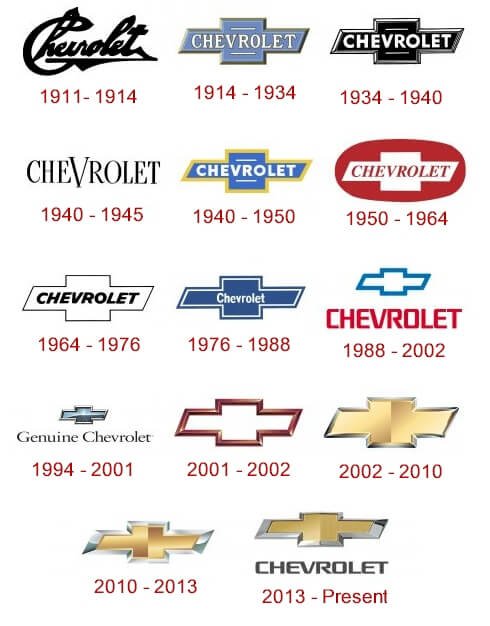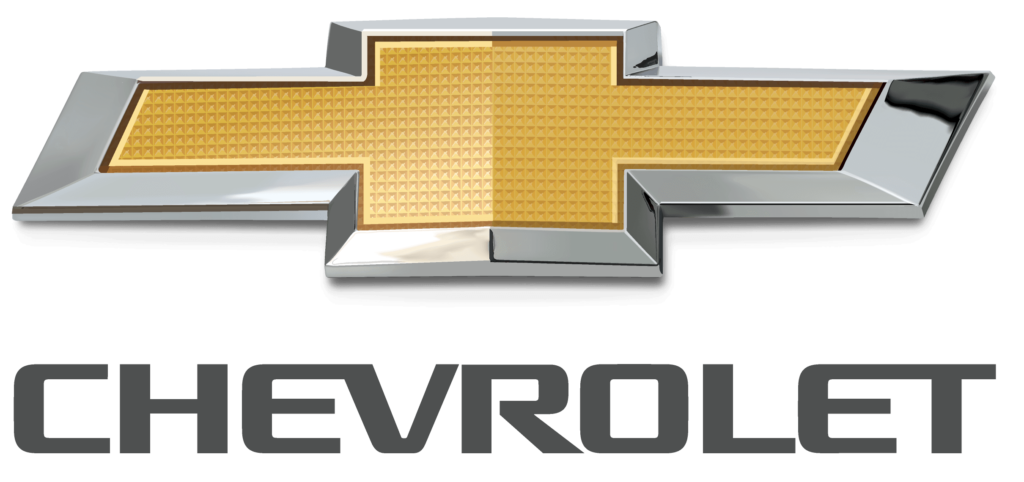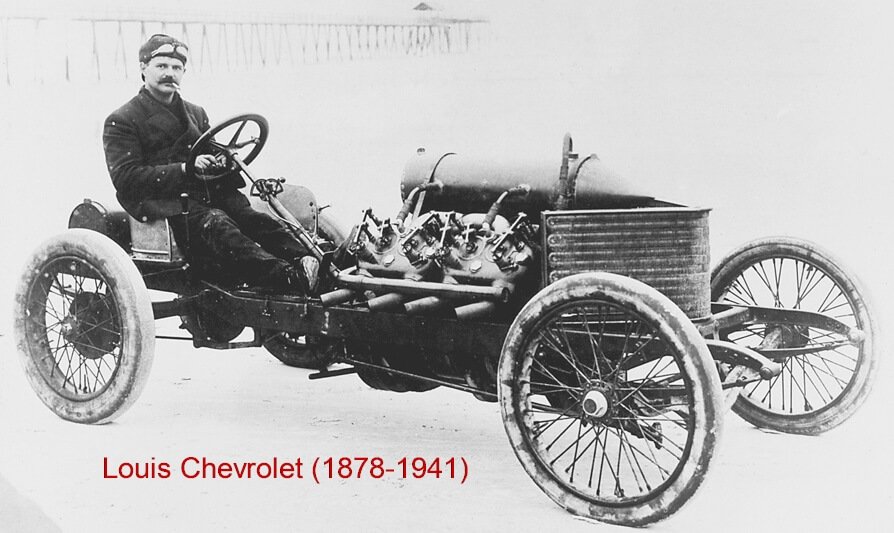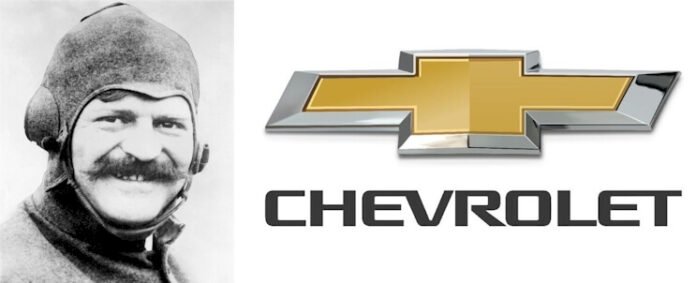The Chevy bowtie logo tries to portray the value provided by the brand on first viewing. Different variants of the bowtie emblem have adorned Chevrolet vehicles for well over 100 years.
Often described as a cross or bowtie, the Chevy logo is easily noticeable wherever you are in the world. However, it’s pretty hard to understand its meaning.
The Chevy logo is a wide, short cross drawn in gold with a grey outline. The cross or bowtie symbol was first unveiled in 1913 by Chevrolet co-founder William C. Durant.
While the date of its unveiling is well-known, Chevrolet says the company’s origins are a little unclear. One theory from Chevy is that Durant saw a pattern on wallpaper while holidaying in Paris and decided to use it as the company’s logo.
Durant’s daughter Margery thinks the design was completely original. According to a book she wrote about her father, Margery said her dad would routinely sketch nameplate designs. And according to Durant’s wife, Catherine, the logo was inspired by a newspaper advert seen in Virginia. Catherine says that Durant saw and liked the ad and believed it’d be perfect for the Chevrolet symbol.
The second theory appears to be the most credible because a variant of the Chevy logo was discovered in a newspaper advert in November 2011 by Ken Kaufmann, the Chevrolet Review’s editor, and historian.
Whatever the case may be, Chevrolet’s bowtie logo is now one of the most recognizable emblems in history. It’s also one of the most iconic logo designs, as many elements have stayed the same throughout its history.
The Chevrolet Logo History and Evolution

No matter its origin, the Chevrolet bowtie emblem is a world-famous visual identity today. Throughout the decades, the design has gone through several minor alterations to make it look more modern.
The “Chevrolet” logotype was also used for decades, but it was eventually ditched in 1985. The emblem has put on weight and lost it and has even been enveloped by other shapes. Here’s the complete evolution of the Chevy logo since its introduction in 1913.
1911: Chevy’s Original Logo Was In Fact a Signature
The Chevy logo was based on the signature of co-founder Louis Chevrolet. It was drawn in a blacked-out, bold handwritten format and was used briefly between 1911 and 1914.
1913: Chevy’s Original Bowtie Emblem is Introduced
The famous bowtie emblem was originally designed in 1913 and spawned the numerous original tales we hear today. This was the start of an iconic branding for one of the oldest vehicle manufacturers in the US.
The first Chevy bowtie logo was subtle as it consisted of white and light blue with a gold outline. The word “Chevrolet” also appeared across the bowtie until 1934.
1934: A Monochrome Design is Introduced
Chevrolet did away with the light-colored palette and adopted a monochrome design with the word “Chevrolet” now rendered in a more up-to-date typeface. The letters were larger and gave the emblem a more serious appearance than the previous one. This version was used up to 1940.
1940: Chevy Becomes Colorful Again
Chevrolet decided to bring back the blue-gold theme, but they opted for a flatter design this time. The colors were more powerful and oozed a youthful vibe. Now the gold outline was thicker and only appeared outside the cross. This version was used until 1957.
1957: Chevy’s Quirkiest Ever Bowtie Is Unveiled
The 1957 Chevy bowtie version is perhaps the weirdest ever designed in the history of the automaker. To begin with, it was a red large oval that contained the bowtie on the inside.
The lettering was red, too, while white highlighted the inside of the symbol. There’s no solid reason why this drastic change was done, but some historians suggest that it could have been to underscore Chevrolet’s performance. This version was short-lived as it was ditched in 1960.
1960: A Minimalistic Chevy Bowtie is Introduced
Chevrolet once again opted for a monochrome design and therefore designed the most minimalistic bowtie logo ever. The symbol was made up of a slimmer black outline, the wordmark was written in italics, and it was finished with black. This version was in use for quite a long time between 1960 and 1977.
1977: The Chevy Bowtie Receives Some Aesthetic Upgrades
Chevy brought back blue, but this time the designers drew inspiration from the previous logo and drew a thin white outline inside the bowtie. The word “Chevrolet” was now placed in the middle of the emblem was smaller.
1985: Chevy Turns the Bowtie into One Emblem
In 1985, the bowtie logo reached a turning point, and this was when the original variant of the current logo we’re very familiar with emerged. In addition, it was the most dramatic alteration which saw the logo gain widespread popularity through its first TV ads.
Chevrolet also jettisoned the “Chevrolet” wordmark on the inside, ending up with the first-ever single symbol logo. This particular version of the logo was in use until 2000.
2000: The Chevy Bowtie Goes 3D
Chevy went red once more in 2000 and they opted for a subtle design this time, based on the single symbol. The flat previous design made way for a 3D design finished in a reddish color. This can be considered the modern minimalist version of the 1960s monochrome.
2004: Chevy Bowtie Starts Using Gold
Chevy began using gold in its bowtie symbol from 2004, which was a departure from the company’s tendency to add bright and weird layers to its emblem. The new look highlighted Chevrolet as one of the world’s most recognizable logos. This version was in use until 2011.
2011: The Chevy Modern Bowtie of Today is Unveiled
In 2011, Chevy adjusted the well-liked golden bowtie logo design and added a thicker silver outline. The gold-filled part also got a patterned appearance, and the symbol was unveiled to celebrate 100 years of Chevrolet’s existence. To date, this is still the company’s corporate logo.
Chevy has done some subtle tweaks to this logo that all its cars show off worldwide. The alterations are minor and have often been done to complement the front grille or contoured surface of the vehicles.
The Chevrolet Logo Design Elements

Symbol: The Chevy bowtie logo is a stylized, wide cross. A square overlaps the horizontal parallelogram, creating a cross figure.
Throughout the history of the Chevy bowtie, many variants in detail and coloring have appeared and disappeared, but the basic shape has stayed the same.
Chevrolet vehicles have displayed the iconic bowtie logo since 1913, making it one of the most enduring logos of all time.
The Chevy bowtie logo always had the “Chevrolet” wordmark inside the emblem, but it was jettisoned altogether in 1985.
The History of Chevrolet
Chevrolet was formed by car racer Louis Chevrolet and GM (General Motors) founder William C. Durant in November 1911. Durant himself had developed cars that swiftly earned a good reputation for performance, value, and durability. Those traits are still at the heart of Chevrolet, the world’s 4th largest automaker brand.
Right from the outset, Chevrolet brought features and technology normally reserved for higher-end cars to its range of affordable trucks and cars. The first Chevrolet car—Series C Classic 6—had an electric starter as well as electric headlamps during an era where both were rare, even in more expensive cars.
In the next several decades, innovations like safety glass, anti-lock brakes, electronic stability control features, and fuel injection were added to Chevrolet models simultaneously with dearer vehicles. As a major brand in the motor vehicle industry, Chevrolet’s early use of landmark technologies primarily changed the manner in which they were used on new vehicles.
In addition, Chevrolet made performance inexpensive. Its original 4- and 6-cylinder engines were popular for strong performance and durability, but the design of the automaker’s small-block V-8 in 1955 was what ushered in a new age of attainable high-performance. The V-8 engine would power countless vehicles in the next five decades, with its legacy handed down to a new class of small-block V-8 engines used in the current SUVs and trucks, in addition to performance cars like the Corvette and Camaro SS.
The performance traits of the V-8 helped position Chevrolet as a major stakeholder in nearly all types of motorsports. In the 1950s, Chevrolet-powered race cars immediately competed in the fledgling drag and stock car races, going on to win most races for decades. In fact, Chevrolet is the most successful car brand in NASCAR history.
Early Chevrolet Years

Born in Switzerland, Louis Chevrolet was a pioneering engineer, mechanic, and racer. William C. Durant was a visionary vehicle marketer. In 1908, Durant established General Motors as Chevrolet continued to build his reputation as an elite racer.
Durant was ousted from General Motors in 1910, but he wouldn’t give up on the fledgling automotive industry. Together with other partners, one of whom was Chevrolet, he regrouped to come up with a new car. As Chevrolet was a renowned racer, Durant believed that Chevrolet’s reputation would help market the car, so they decided to name it Chevrolet.
So, in 1911, the Chevrolet Motor Car Inc. was founded, and its first-ever car was a huge, finely built motor car called the Series C Classic 6. Its large 6-cylinder, 4.9-liter engine hit a top speed of around 65 mph. It went for $2,150 or almost $50,000 today, taking inflation into account.
Despite being expensive, the Chevrolet was renowned for style, comfort, and precision. Durant was also designing a smaller, fairly inexpensive car known as the Little. Both cars were selling really well, but Durant became aware of the potential of the entry-level market and steered Chevrolet in that direction.
So, the Chevrolet Little and Series C were produced until 1913. The following year, the basic Little design was remodeled to Model L, which was followed by the introduction of Model H later that year.
The refocused Chevrolet range was successful right away, thanks to a powerful 4-cylinder engine that was very durable and its competitive price. Despite the early success of Chevrolet, the co-founders differed about the philosophy of Chevrolet’s products. The differences between them led to Durant buying Chevrolet out of the firm in 1915.
Customers eventually warmed up to Durant’s vision, and the company’s sales continued to increase. The success helped Durant ultimately become a major shareholder in General Motors a year later. In 1917, Durant took full control of GM and made Chevrolet one of its divisions.
Durant left GM in 1920. He founded another car manufacturing business and became a well-known Wall Street investor. In 1929, the stock market took a dive and brought both his ventures to an end. He was declared bankrupt in 1936 and died 11 years later.
Louis Chevrolet also saw his fortune disappear during the disastrous Great Depression. He went back to working as a Chevrolet mechanic in Detroit and died in 1941.
Recent Chevrolet Years
Chevrolet has not only become an American icon over the past 60 years but also a worldwide one. In 2010, Chevrolet designed the plug-in hybrid known as Chevrolet Volt, which won several industry awards in the US and internationally.
In October 2016, Chevrolet launched the Bolt EV, giving the company its first genuinely affordable all-electric, mass-market car with over 200 miles of range. Moreover, vehicles such as the Chevrolet Tahoe and Chevrolet Silverado 1500 continue to provide incredible capabilities and performance for a variety of driving conditions.
Wrap Up the History of Chevrolet
Chevrolet, affectionately nicknamed the Chevy, is a US automobile division of American car maker General Motors (GM). The company was started in 1911 as the Chevrolet Motor Car Company by Louis Chevrolet and GM founder William C. Durant.
The first official Chevrolet model, the Series C Classic 6, only hit the market in 1913, and the well-known bowtie logo was introduced only after the 1914 Model H series were introduced. Chevrolet was incorporated into General Motors in 1919 and became famous for its high-quality trucks.
In America, the Chevrolet portfolio boasts iconic performance cars like the Camaro and Corvette, reliable, long-lasting SUVs and pickups like Suburban and Silverado, as well as award-winning crossovers and passenger cars like Traverse, Equinox, and Malibu.
Most new models from Chevrolet offer convenience, safety, and security technologies like OnStar Hands-free Calling, among others, as well as Stolen Vehicle Showdown and Automatic Crash Response.







